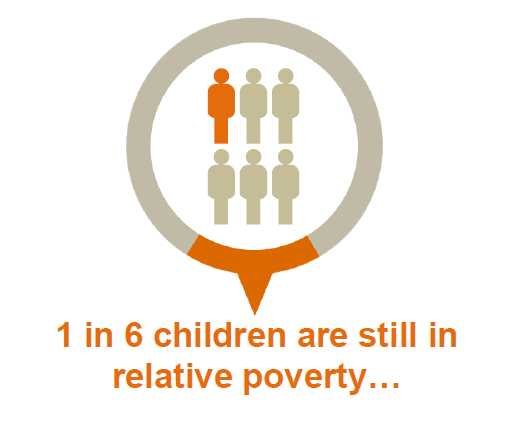
Graphic from Social Mobility and Child Poverty Commission
By Morwen Johnson
Current forecasts suggest that across the UK, 4.7m children will be living in poverty by 2020 (equivalent to nearly the population of Scotland). This is despite the fact that the Child Poverty Act 2010 legally binds the UK Government to a commitment to end child poverty by 2020. This commitment was reiterated in the Conservative’s pre-election manifesto.
Two recently published briefing papers from the Scottish Universities Insight Institute review the literature on poverty and children’s health and wellbeing, and poverty and children’s education. The findings add to an extensive evidence base confirming the long-term negative impact of child poverty on life chances and adult outcomes.
At the report launch event in May, there was extensive discussion about the continuing challenge of reducing child poverty, especially in the context of George Osborne’s pledge to make £12bn of cuts to the welfare budget by the financial year 2017-18.
Rise in in-work poverty
As the rhetoric in both politics and the popular press swings back to presenting the economy in a positive light, it’s easy to forget that economic growth must also result in quality jobs. Analysis by the Social Mobility and Child Poverty Commission shows that 5 million Britons are in jobs earning less than £7.50 an hour. And a quarter of these have been stuck in this situation for more than a decade.
Douglas Hamilton, one of the Commissioners of the Social Mobility and Child Poverty Commission who spoke at the Scottish Universities Insight Institute event, suggested that policy approaches which rely on welfare to work to meet child poverty targets are doomed, as this ignores the fact that getting parents into work can still leave children living in poverty. In fact the number of children in poverty living in workless households is at an all-time low.
Social justice and economic imperative
The Social Mobility and Child Poverty Commission said in its State of the Nation report last year that the challenge was “… to prevent Britain becoming a permanently divided society and ensure there is a social recovery alongside the economic recovery.” Donald Hirsch of the Centre for Research in Social Policy has estimated that child poverty costs £29bn each year in costs to the Exchequer and reduced GDP – an economic justification for continuing to address child poverty in a targeted way. However, if issues such as underemployment and a lack of affordable housing are allowed to become a norm in our society, it will inevitably impact on the likelihood of reducing child poverty.
Debates over how child poverty is defined and measured are likely to continue, but should not obscure the very real, everyday consequences for children of growing up in poverty. Research by Scotland’s Commissioner for Children and Young People found that children living in poverty struggled with having school uniforms, resources for school work, going on school trips and having basics such as housing and food. Unfortunately, stigma can also dissuade families from registering their children for free school meals.
1 in 6 children are still living in relative poverty in the UK. And that seems to be a reality which no one wants to put on the front page of the newspapers.
Read some of our other blogs looking at the issue of poverty:
- Spreading the word on the living wage
- Addressing the causes of in-work poverty
- Going hungry? The growth of food poverty and food banks in the UK
Become a member of the Idox Information Service now, to access a wealth of further information on social exclusion and poverty, including case studies and commentary. Contact us for more details.


You must be logged in to post a comment.